As the car rental industry speeds ahead with mobile innovation, car rental apps have become the go-to solution for travelers seeking ease, cost-efficiency, and freedom on the go.
But how do car rental apps make money?
The secret lies in choosing the right car rental app business model and applying proven monetization strategies that unlock consistent revenue.
If you're planning to develop a car rental app, understanding how to build strong, lasting revenue streams is key to long-term success.
From commissions and subscriptions to premium add-ons and partnerships, there are multiple ways to monetize your app effectively.
The best revenue model depends on your target audience and the features your app brings to the table.
This blog dives into the most effective car rental app monetization strategies, helping you select the right model for sustainable growth and profitability.
Market Stats of Car Rental
Before we delve into the best revenue models for car rental apps, let's take a quick look at some key market statistics that highlight the lucrative nature of this industry:
-
- Global Market Growth: The global car rental market was valued at USD 149.87 billion in 2024 and is projected to reach USD 278.03 billion by 2030, growing at a CAGR of 10.5% from 2025 to 2030.
- U.S. Market Size: In the United States, the car rental market reached USD 37.88 billion in 2024 and is expected to grow at a CAGR of 7.5% from 2025 to 2030.
- Digital Booking Trends: The U.S. car rental market is evolving with digital transformation. While the market grew modestly by 5% in 2023, the transition to online bookings continues to reshape the landscape, with 70% of rentals expected to be booked digitally by 2027.
- Regional Market Share: North America accounted for 36.4% of the global car rental market revenue in 2024, with the U.S. projected to lead in revenue by 2030.
- Asia-Pacific Growth Potential: The Asia-Pacific car rental market is expected to grow at a CAGR of 8.5% during the forecast period, driven by rising disposable incomes, growing economies, and increased business travel, particularly in countries like China and India.
With these impressive market stats in mind, it's clear that the car rental app market is full of opportunities.
What is Car Rental App Monetization?
Let's get one thing straight: your car rental app isn't just a cool tech tool. It's a business tool. And car rental app monetization is how you fuel that engine for the long haul.
So, what exactly is it?
Car rental app monetization refers to the strategies, models, and methods used to create revenue from your platform.
It's all about changing your app from just "functional" to financially beneficial. Think of it as your path to steady cash flow.
Whether you're targeting cheap travelers, luxury renters, or daily workers, the goal stays the same: maximize your car rental app revenue without compromising user experience.
And that's where smart monetization steps in. Here are a few popular car rental app revenue streams to get your wheels turning:
-
- Commission-based Booking: Take a cut from every transaction made through your app. Simple, successful, and scalable.
- Car Rental App Subscription Model: Offer VIP plans or premium groups with perks like early bookings, savings, or exclusive cars.
- In-app Promotions & Ads: Partner with nearby businesses, fuel stores, or insurance providers to run focused ads.
- Add-on Services: GPS, insurance coverage, child seats, or even butler pick-up, monetize these things to boost per-user income.
- Affiliate Partnerships: Collaborate with hotels, travel agencies, or tour operators for cross-platform revenue share.
The real magic? Picking a model (or mix) that fits with your user behavior, market goals, and growth plans.
Because the right monetization approach doesn't just bring in money, it builds a brand that keeps people coming back.
In a competitive market, you need more than just a good app: you need a revenue plan that drives results.
Now that you know what car rental app monetization is, let's study which models actually work best in 2025.
Why Monetization Matters for Your Car Rental App's Success?
Developing a mobile app isn't cheap, especially when you're building a feature-rich car rental app.
That's why knowing how car rental apps make money is important right from the start.
Why? Because it's not just about building a sleek, modern app; it's about ensuring it produces constant income to support and grow your business.
For a successful car rental app business, a good business model is necessary. It doesn't just keep your platform alive: it sets you up for long-term success.
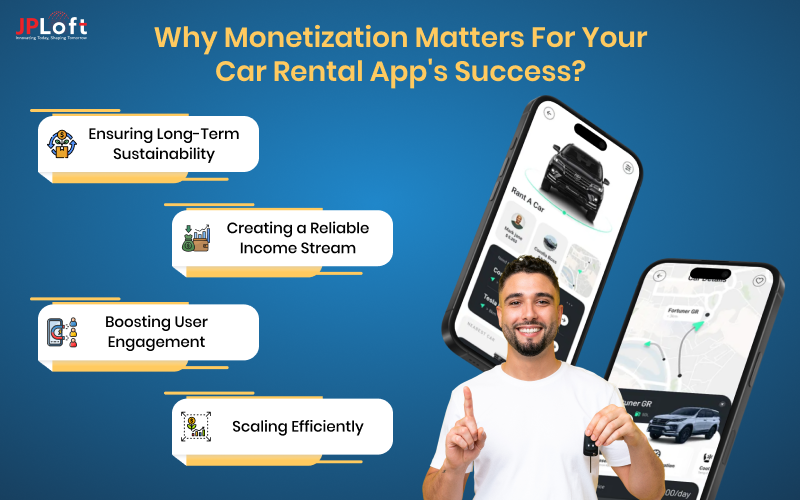
Let's break down the key benefits:
A] Ensuring Long-Term Sustainability
Even the most creative and well-designed app can flop without a clear monetization plan.
Did you know that 83% of apps fail due to the lack of a solid revenue model?
A solid car rental app revenue model helps keep your business competitive and ensures it doesn’t stall after launch.
Whether you’re a startup or a growing business, monetization keeps your engine going smoothly.
B] Creating a Reliable Income Stream
A well-crafted car rental app monetization plan allows you to generate revenue through bookings, commissions, changeable prices, partnerships, and even subscription models.
The more choices you explore, the more revenue streams you open.
C] Boosting User Engagement
Believe it or not, monetization and involvement go hand in hand.
Offering perks like loyalty rewards, priority booking, or premium car access not only boosts income but also keeps users coming back for more.
When you’re mapping out the features for a car rental app, it’s smart to include monetization tools that enhance both user satisfaction and your bottom line.
These features improve the overall experience while actively driving your financial goals, making your app profitable and irresistible.
D] Scaling Efficiently
Apps like Turo and Getaround didn't just scale by luck; they used smart revenue models to get there.
Whether it's through in-app upselling, partner programs, or paid services, the best revenue models for car rental apps help you grow without burning through your budget.
Want to turn your car rental app into a money-making machine?
Let's hit the road and explore the best monetization strategies that fuel both growth and profit.
Most Common Monetization Models in Car Rental Apps
How do car rental apps make money? Good question, and the answer lies in picking the right monetization models that match user happiness with good profit.
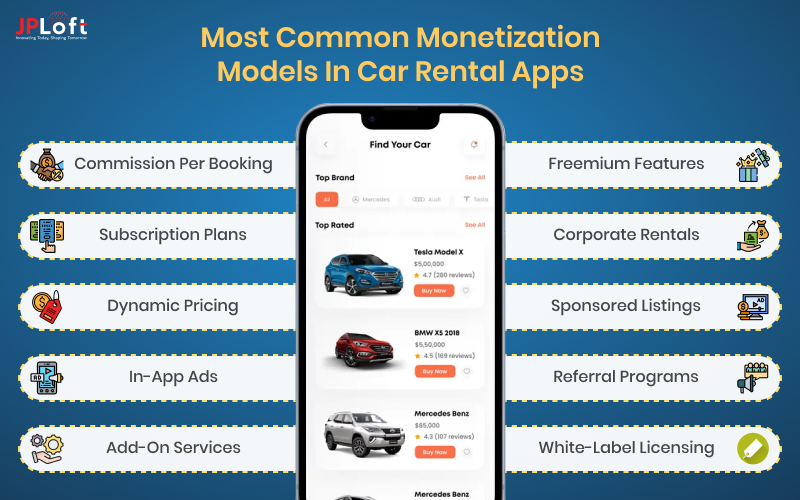
Whether you're starting your first app or improving a current one, here's how the top players roll:
1. Commission Per Booking
One of the simplest ways car rental apps make money is by charging a fee on every successful booking made through the platform.
Whether it's a peer-to-peer rental or a business fleet, you earn a slice of the deal.
Each time a user hires a car, your app takes a set percentage or service fee, with no extra effort needed.
This model is simple to adopt, works with almost every business type, and scales nicely as your user base grows.
The more rentals, the more revenue. Now that’s what we call silent power!
Benefits:
-
- Generates consistent revenue from every booking.
- No upfront cost for users, which encourages more rentals.
- Works seamlessly for both individual car owners and rental companies.
Revenue Potential: Commission-based monetization delivers a steady income stream that scales directly with usage. With more bookings and expanding listings, your profits grow without limits.
2. Subscription Plans
Who doesn’t love a VIP pass?
With subscription plans, your car rental app can offer users exclusive perks like free upgrades, early vehicle access, better rates, or even personal concierge service for premium members.
Think of it as turning your loyal users into first-class travelers.
Customers pay monthly or annually for these benefits, providing your business with a predictable and steady cash flow.
It’s especially appealing to repeat renters and business travelers who value convenience and efficiency.
As you explore this monetization model, don’t forget to consider the cost to create a car rental app.
Factoring in features like subscription management, user segmentation, and automated billing can influence your overall budget, but done right, it’s an investment that pays off.
This model builds loyalty, increases participation, and gives your app a competitive edge in a crowded market.
Benefits:
-
- Predictable, recurring revenue stream.
- Builds brand loyalty with exclusive experiences.
- Attracts high-value users who rent frequently.
Revenue Potential: With a well-structured car rental app subscription model, you create long-term relationships that translate into consistent income. Premium tiers = premium profits.
3. Dynamic Pricing
Ever notice how flight prices spike when you're booking that last-minute weekend getaway? That's dynamic pricing, baby, and it works like a charm for car rentals, too.
With this model, your app automatically adjusts rental rates based on demand, season, or even location.
Holidays, weekends, local events? Prices go up. Off-season lull? Offer discounts to keep the wheels turning. It's smart, flexible, and oh-so-lucrative.
This revenue strategy not only maximizes profits during peak periods but also ensures your fleet is efficiently used year-round.
Plus, it subtly nudges users to book early to lock in better rates: win-win!
Benefits:
-
- Boosts earnings during high-demand times.
- Balances supply and demand like a boss.
- Encourages users to plan and commit early.
Revenue Potential: Dynamic pricing helps unlock serious car rental app revenue streams by capitalizing on real-time trends and customer urgency. Surge your way to success, darling.
4. In-App Ads
Think of in-app ads as your silent money-maker. You're not charging users directly, but you're cashing in every time a banner shows up or a sponsored offer gets a click.
Partner with relevant businesses, such as travel agencies, fuel stations, insurance providers, or hotels, and turn your car rental app into prime advertising real estate.
With a large user base, these brands will gladly pay for visibility. But while monetization through ads, app security should never take the backseat.
Every click and every impression involves user data, so your app must be built with strong encryption and secure ad integrations. That way, you earn trust while earning revenue.
The best part? Ads are easy to integrate and can be personalized based on user behavior or trip details, keeping the experience smooth, smart, and safe.
Benefits:
-
- Generates passive revenue.
- Doesn’t rely on users spending money.
- Scales easily with user base growth.
Revenue Potential: With targeted ads and strategic brand partnerships, this model adds a steady car rental app revenue stream: no strings attached. Just eyes on screens and dollars in the bank.
5. Add-On Services
Add-on services are the unsung heroes of car rental app monetization.
From GPS systems and baby seats to travel insurance and extended roadside assistance, these extras offer more than just convenience; they significantly boost your bottom line.
By presenting optional upgrades during the booking process, you enhance the customer experience while subtly increasing the average transaction value.
Most users are willing to pay a bit more for added comfort or peace of mind, and that "bit more" adds up fast.
These upsells typically come with low operational costs but carry high margins, making them a smart and scalable revenue stream for a car rental app.
Benefits:
-
- Increases average revenue per booking.
- Enhances customer satisfaction.
- High profit margins on low-cost features.
Revenue Potential: Add-on services quietly but consistently drive revenue, making them a must-have in your monetization toolkit.
6. Freemium Features
The freemium model strikes a smart balance between accessibility and exclusivity.
You offer the core services, like basic car rentals, for free or at a minimal cost, then lock premium perks such as luxury car access, concierge services, or zero-deposit bookings behind a paywall.
This approach gets users through the digital door without friction, then teases them with upgrades that enhance their rental experience.
Once users get a taste of the app's convenience, many are willing to pay for added value.
It's a flexible strategy that scales with user demand while nudging loyal customers toward high-yield features. It's subtle, effective, and powerful for boosting car rental app revenue.
Benefits:
-
- Reduces entry barriers for new users.
- Converts free users into paying customers.
- Supports a wide range of user preferences.
Revenue Potential: A well-structured freemium model encourages organic growth while offering strong monetization opportunities at scale.
7. Corporate Rentals
Tap into the high-volume, high-value world of business clients with corporate rental plans.
These tailored offerings cater to companies that need regular vehicle access, such as hotels, travel agencies, event planners, and enterprise teams.
Instead of one-time users, you gain long-term partners who bring in recurring revenue through bulk bookings and customized service contracts.
It's a goldmine for predictable cash flow and efficient fleet utilization.
To build and scale this model seamlessly, you'll need support from the best mobile app development company, one that understands both business logic and user experience.
Corporate rentals also boost brand credibility and open the door for strategic partnerships that lead to even more bookings and growth.
Benefits:
-
- Secures large, consistent contracts.
- Maximizes fleet usage with minimal marketing effort.
- Builds brand loyalty with business clients.
Revenue Potential: By locking in bulk bookings and long-term contracts, corporate rentals can become one of the most reliable and profitable car rental app revenue streams in your monetization strategy.
8. Sponsored Listings
Let rental agencies or individual car owners pay to appear at the top of search results. When visibility equals more bookings, partners will gladly pay for premium placement.
Sponsored listings turn your platform into valuable real estate. It’s a non-intrusive revenue stream that boosts your car rental app monetization while offering extra value to businesses looking to stand out.
This model works especially well in competitive markets where everyone wants to be seen first.
Benefits:
-
- Generates extra income without disrupting user experience.
- Appeals to rental providers aiming for higher visibility.
- Adds a B2B revenue layer to your platform.
Revenue Potential: Whether it’s a new agency trying to build momentum or a fleet owner looking to dominate, sponsored listings offer a steady stream of income that grows with your user base.
9. Referral Programs
Referral Programs Reward users for referring friends with discounts or app credits. It's a win-win: they get perks, and you get more users who make more bookings.
Referral programs are a low-cost but powerful way to grow your user base organically.
Every new user means more potential revenue, and incentivizing referrals turns your customers into your marketing team.
Why it works:
-
- Low-cost customer acquisition.
- Boosts app installs and engagement.
- Builds a loyal user base through word-of-mouth.
Revenue Potential: Referral programs can accelerate user growth, especially when your car rental app offers standout features users are excited to share.
By incentivizing referrals with discounts or ride credits, you can expand your user base organically while boosting engagement and bookings.
When designing your referral strategy, it’s important to keep the car rental app development cost in mind.
A well-planned marketing approach should align with your overall budget and long-term growth goals, ensuring every dollar spent contributes to higher ROI.
10. White-Label Licensing
Sell your app platform to other startups or rental companies under their branding. They get a turnkey solution, and you get recurring revenue.
This approach turns your tech into a product.
Whether it's a local agency or a new market entrant, many businesses prefer a ready-made solution they can brand and launch quickly, and you become their silent partner in success.
Why it works:
-
- Expand your market without extra overhead.
- Brings in consistent license and setup fees.
- Ideal for SaaS-style scalability.
Revenue Potential: High. With multiple clients using your platform under different brands, you unlock a whole new revenue stream beyond your customer base.
Licensing gives your product legs and your business wings.
Mix, match, and monetize: that's the secret sauce behind every successful car rental app. Ready to turn traffic into treasure?
How Top Car Rental Apps Make Money?
Car rental apps have transformed the travel game, offering wheels on demand with just a few taps.
But while users are out cruising, these apps are raking in serious revenue behind the scenes.
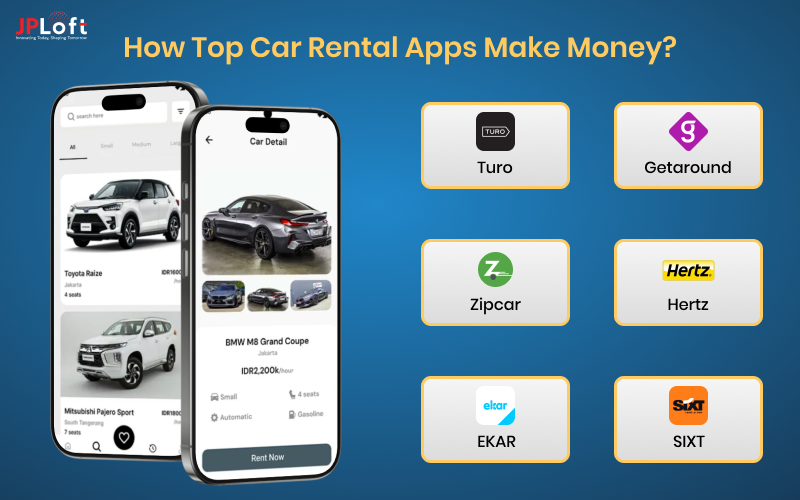
Let’s peek under the hood and see how the world’s best car rental apps make money:
1. Turo: The Peer-to-Peer Powerhouse
Turo lets individual car owners rent out their vehicles, creating an Airbnb-style marketplace for cars.
If you want to build a car rental app like Turo, you can implement a similar model, earning by taking a commission from each transaction and charging for extras like insurance and protection plans.
Monetization Model: Commission Per Booking, Add-On Services, Insurance Fees.
2. Getaround: Instant Access Rentals
Getaround works similarly to Turo but emphasizes instant rentals and hourly pricing.
It also offers subscription plans for frequent renters and charges owners a monthly fee for hardware that enables remote unlocking.
Monetization Model: Usage-Based Fees, Subscriptions, Hardware Leasing, Commission.
3. Zipcar: Subscription-Based Simplicity
Zipcar pioneered the car-sharing space with a pure subscription model.
Users pay a monthly or annual fee to access cars by the hour or day, which is ideal for urban dwellers who don’t own a car.
Monetization Model: Membership Subscriptions, Hourly/Daily Usage Fees, Late Fees.
4. Hertz: Traditional Meets Digital
Hertz blends the legacy rental model with a modern app interface.
Beyond standard rentals, it monetizes through premium vehicle upgrades, loyalty programs, and B2B corporate contracts.
Monetization Model: Rental Fees, Premium Upgrades, Corporate Rentals, Loyalty Points.
5. EKAR: Peer-to-Peer Car Sharing
EKAR operates on a peer-to-peer model, allowing individuals to rent out their cars to others through the platform.
Users can access a wide range of vehicles on demand, and car owners earn revenue from renting their cars.
If you're wondering about the cost of developing a car rental app like EKAR, it's essential to factor in features like real-time booking, secure payment systems, and user profiles.
This model promotes flexibility, making it attractive for both car owners and renters.
Monetization Model: Commission Per Booking, Add-On Services, Insurance Fees.
6. SIXT: Luxury on Demand
SIXT targets both economy and premium renters.
With a global presence, it earns via dynamic pricing, in-app upsells like insurance or GPS, and integrates car subscriptions for long-term users.
Monetization Model: Dynamic Pricing, Add-On Services, Car Subscriptions, B2B Solutions.
How Do You Select the Right Monetization Model for Your Car Rental App?
Understanding how car rental apps make money is just the starting line. The real race? Picking the mobile app monetization model that turns your app into a revenue-generating engine.
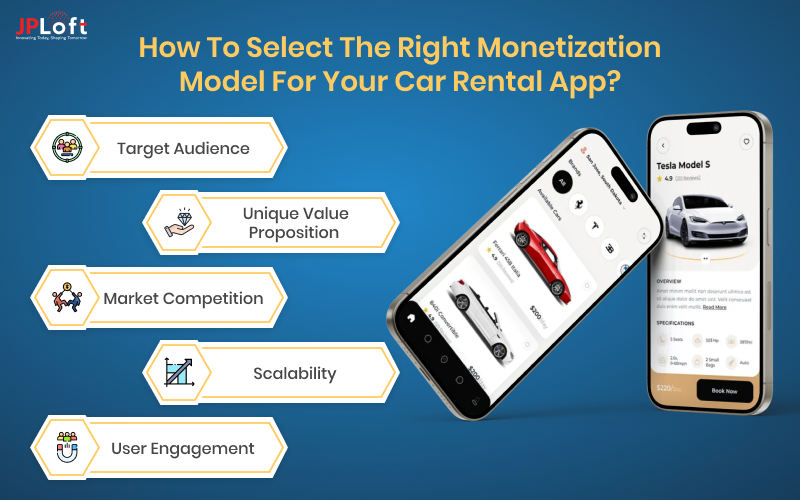
The best car rental app business model depends on a few key factors, and trust us, these are non-negotiable for long-term success:
► Target Audience
Are your users weekend road-trippers, daily commuters, or corporate clients booking in bulk?
Casual renters might respond well to dynamic pricing or freemium features, while business users prefer subscription plans and tailored packages.
Know your user base inside out and design around their needs.
► Unique Value Proposition
What makes your app stand out on the road?
Is it luxury vehicles on demand, 24/7 roadside assistance, or seamless pickup/drop-off experiences?
Leverage your strengths to justify premium features, priority access, or higher service charges.
► Market Competition
Peek under the hood of your rivals. What are other car rental apps doing well, and where are they stalling?
Analyzing local and global competitors helps you identify winning models like commission-based booking, in-app ads, or partnerships with fuel stations and travel brands.
► Scalability
Your app isn’t just a one-way trip. You want it to grow with demand, locations, and user types.
Choose a flexible monetization model that can handle more vehicles, partnerships, and services without breaking down.
► User Engagement
The more your users interact, the more opportunities to monetize.
Loyalty programs, referral bonuses, and value-added services keep them coming back and spending more.
Ready to drive your monetization strategy forward? Let’s shift into high gear.
How JPLoft Can Help You Build a Profitable Car Rental App
The car rental industry is evolving fast, and mobile apps are leading the charge.
Whether you're launching a peer-to-peer platform or managing a fleet, now's the time to turn your idea into a revenue-driving solution.
Partner with JPLoft, a leading car rental app development company, to build a scalable, feature-rich, and monetization-ready app.
From real-time bookings and GPS tracking to secure payments and dynamic pricing, we've got the tools and expertise.
Bring your vision, and we'll create a high-performance app that engages users and fuels growth.
Let's build success on wheels; contact JPLoft today.
Conclusion
Understanding how car rental apps generate revenue is key to building a successful, scalable business.
Whether it’s through subscription plans, dynamic pricing, or peer-to-peer rentals, there are multiple monetization paths to explore.
The secret lies in choosing the right mix of revenue streams that align with your audience and business goals.
By continuously refining your strategy and adapting to market trends, your car rental app can stand out, deliver real value to users, and drive long-term profitability.
FAQs
Car rental apps earn revenue through commissions, subscriptions, dynamic pricing, in-app ads, and premium services, maximizing user demand and convenience.
The latest trends in car rental apps include peer-to-peer rentals, subscription services, dynamic pricing, and upselling add-ons like insurance and GPS. These strategies help build stable revenue streams.
Free car rental apps generate revenue through ads, in-app purchases for add-ons, and premium features like priority access or discounts.
The most profitable car rental apps combine booking commissions, subscription plans, dynamic pricing, and premium features to maximize revenue.
Yes, ads can generate significant revenue, especially for apps with large user bases. Strategically placed ads enhance income without disrupting user experience.





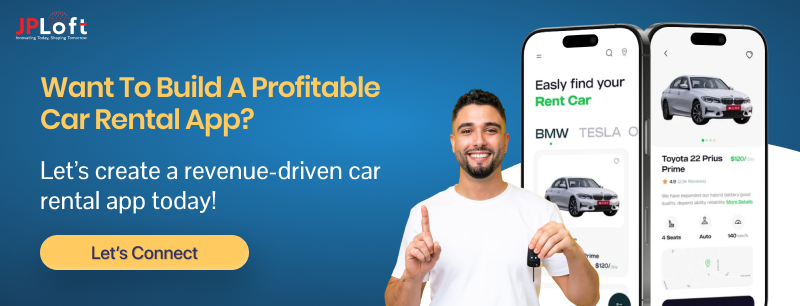
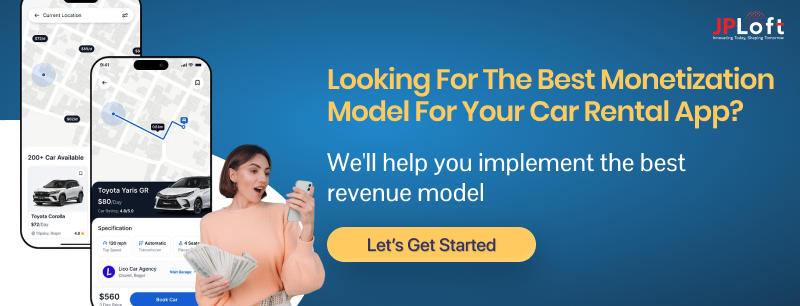
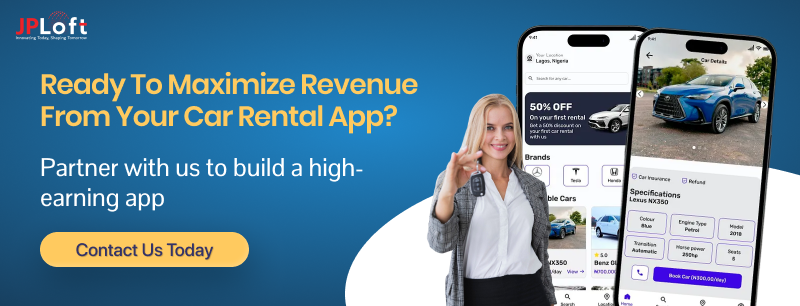

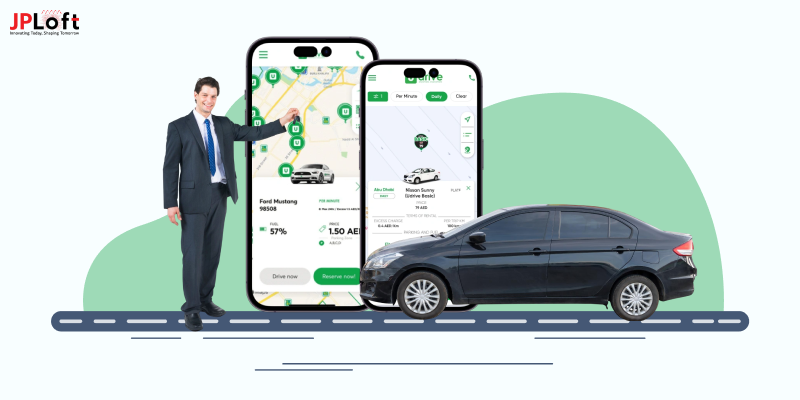
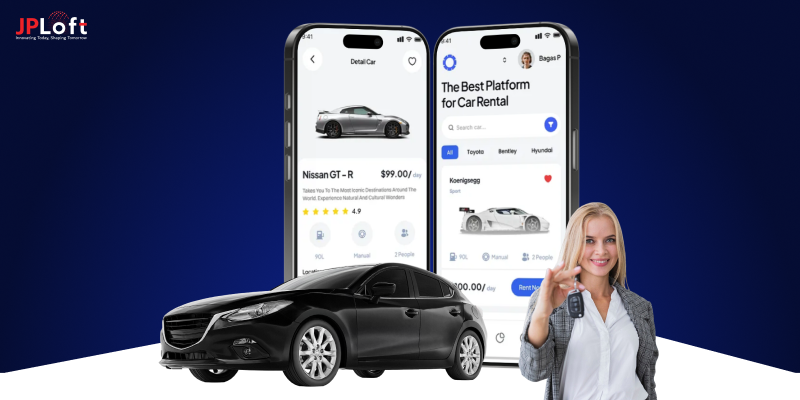
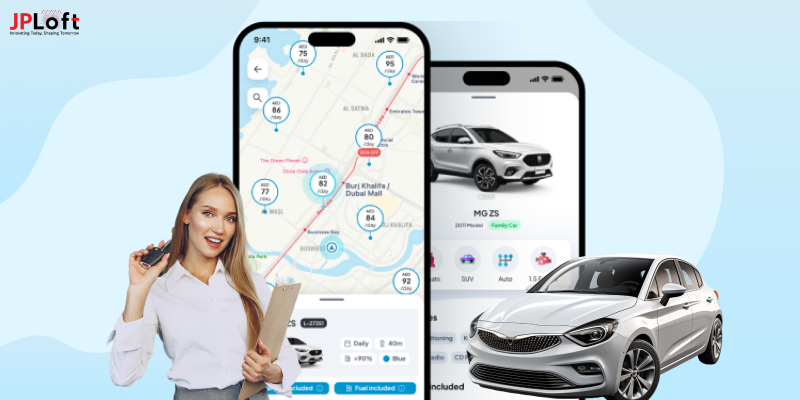


Share this blog